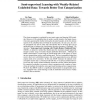1118 search results - page 28 / 224 » Relational temporal difference learning |
ICALT
2009
IEEE
13 years 9 months ago
2009
IEEE
Eye-tracking measurements may be used as a method of identifying users' actual behavior in a hypermedia setting. In this research, an eye-tracking experiment was conducted in...
ATAL
2008
Springer
14 years 1 months ago
2008
Springer
Many multiagent problems comprise subtasks which can be considered as reinforcement learning (RL) problems. In addition to classical temporal difference methods, evolutionary algo...
NIPS
2008
14 years 18 days ago
2008
The cluster assumption is exploited by most semi-supervised learning (SSL) methods. However, if the unlabeled data is merely weakly related to the target classes, it becomes quest...
ISCIS
2009
Springer
14 years 5 months ago
2009
Springer
—In this paper, we study how a humanoid robot can learn affordance relations in his environment through its own interactions in an unsupervised way. Specifically, we developed a...
COST
2009
Springer
13 years 9 months ago
2009
Springer
Synchrony is claimed by psychology as a crucial parameter of any social interaction: to give to human a feeling of natural interaction, a feeling of agency [17], an agent must be a...

